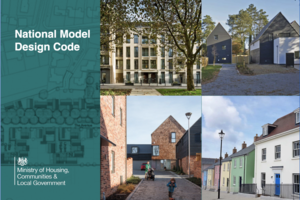The 14 testbed local authorities for the new national design code to ensure areas are beautiful, well-designed and locally-led, have been selected from around England.
They include Guildford, Leeds, Buckinghamshire, Southwark and Portsmouth.
Each of the 14 will be given £50,000 each to develop a new design code that sets out design principles for new development; supports the enhancement of the character of the local area (for example by using local building materials like honey-coloured stone in the Cotswolds or red brick in the Midlands); and explores how communities can be given a real say in the layout, design and appearance of buildings in their area.
Introduction of the code is designed to ensure future developments are 'beautiful' and fit in with local character by giving local planning authorities a toolkit of design principles to consider for new developments, such as street character, building type and façade as well as environmental, heritage and wellbeing factors.
The shortlisted councils will take part in a 6-month testing programme to apply the National Model Design Code (NMDC) in their area, by making sure current and new residents alike will benefit from beautiful homes in well-designed neighbourhoods, says the Ministry of Communities, Housing & Local Government.
It is intended to provide councils with the guidance and parameters to shape new developments in a way which reflects what their communities truly want.
The measures mean the word “beauty” will be prioritised in planning rules for the first time since the system was created in 1947 – going back to a previous time when there was a greater emphasis on whether a building was considered attractive to local people. The government recently consulted on changes to the National Planning Policy Framework to take this forward, alongside the draft NMDC.
Following a consultation period, more than 70 Expression of Interest submissions were received to test the NMDC, with representation from every region of England.
The final 14 applicants were then shortlisted to ensure a geographical spread and a range of development types, including an urban conservation area with industrial heritage, town centres, new neighbourhoods, rural settlements and urban regeneration sites. Each pilot receives a £50,000 grant to carry out the project.
Housing Minister Rt Hon Christopher Pincher MP said:
We should aspire to enhance the beauty of our local areas and pass our cultural heritage onto our successors, enriched not diminished.
In order to do that, we need to bring about a profound and lasting change in the buildings that we build, which is one of the reasons we are placing a greater emphasis on locally popular design, quality and access to nature, through our national planning policies and introducing the National Model Design Code.
These will enable local people to set the rules for what developments in their area should look like, ensuring that they reflect and enhance their surroundings and preserve our local character and identity.
Instead of developers forcing plans on locals, they will need to adapt to proposals from local people, ensuring that current and new residents alike will benefit from beautiful homes in well-designed neighbourhoods.
Anna Rose, Head of the government's Planning Advisory Service said:
It is really exciting to see the National Model Design Code being tested by local councils across the country. The outcomes from this first set of pilots will help to build the capacity and collective learning that we need across the sector. I am looking forward to seeing what councils can achieve with their communities by using this new code.
The testing programme is a step towards this aim and the findings will help inform potential further developments to the NMDC and the use of design coding in the planning system.
Newcastle's Cabinet member for Neighbourhoods and Transport, Cllr Ged Bell, said his council was delighted to have been chosen by MHCLG to take part in the pilot programme for proposed new design codes.
They are all about ensuring that developments are designed to the highest quality which is fundamentally important for communities who live and work in them. The Ouseburn is recognised nationally for successful city centre regeneration in a historical setting, and we are determined to maintain those high standards.
The NMDC is part of a wider strategy as outlined in the 190-page ‘Living with Beauty’ report published in January 2020 which proposed a new development and planning framework, with 3 principle goals – to ask for beauty, refuse ugliness and promote stewardship.
Nicholas Boys Smith, founding director of social enterprise Create Streets and co-chair for the Building Better Building Beautiful Commission, whose report led to the new approach, said:
The pilots are a very important first step as councils start to grapple again with how they can define visions for development in their areas which are popularly-beautiful, profoundly locally based and will support lives which are happy, healthy and sustainable.
The 14 successful applicants are:
| Local authority | Region |
|---|---|
| Colchester Borough Council, Tendring District Council and Essex County Council | East |
| Guildford Borough Council | South East |
| Herefordshire Council | West Midlands |
| Leeds City Council | Yorkshire & Humber |
| Mid Devon Council | South West |
| Newcastle City Council | North East |
| Dacorum Borough Council | East |
| Portsmouth City Council | South East |
| Sefton Council | North West |
| Southwark Council | London |
| Hyndburn Borough Council | North West |
| North West Leicestershire District Council | East Midlands |
| Nuneaton and Bedworth Borough Council | West Midlands |
| Buckinghamshire Council |


